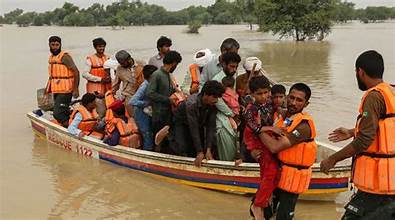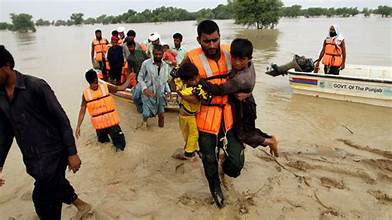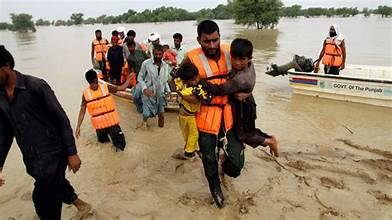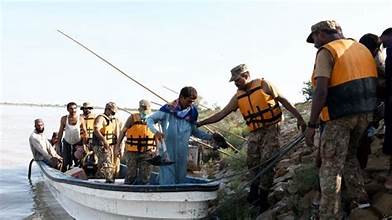Floods have once again struck Pakistan, bringing devastation to Punjab, one of the country’s most vital provinces both demographically and economically. In response, the Pakistan Army has continued extensive rescue and relief operations to support communities that have been displaced, cut off, or otherwise impacted by floodwaters. This effort underscores the armed forces’ pivotal role in disaster management, especially when civilian institutions are overwhelmed by the scale of natural calamities.
This year’s flooding, driven by torrential monsoon rains and rising river levels, has submerged villages, washed away farmland, and displaced thousands of families. Against this backdrop, the Pakistan Army’s presence has become a source of both immediate relief and long-term stability for vulnerable communities.
Scale of Flooding in Punjab
Punjab, often referred to as the “heart of Pakistan,” is not only the country’s most populous province but also the backbone of its agricultural sector. The province’s fertile plains are nourished by rivers such as the Sutlej, Ravi, Chenab, and Indus. However, when excessive rains combine with upstream water releases, these same rivers transform into destructive torrents.
The recent floods have:
- Inundated large swathes of farmland.
- Damaged homes and public infrastructure such as schools, health centers, and roads.
- Disrupted power and communication lines.
- Forced thousands of people to seek shelter in relief camps or makeshift tents.
Amid these conditions, the Army’s ability to mobilize quickly and reach remote or inaccessible areas has been vital in preventing an even greater humanitarian crisis.
Army’s Rescue Operations on the Ground
The Pakistan Army has deployed troops, helicopters, boats, and medical teams to flood-hit districts across Punjab. Their operations encompass several dimensions:
- Evacuation of Stranded Families
Army personnel, equipped with motorboats and helicopters, have been evacuating people from marooned villages. Special attention is being given to women, children, and the elderly, who are often the most vulnerable during such emergencies. - Establishment of Relief Camps
Temporary shelters have been established by the Army, providing affected families with food, clean drinking water, and basic medical care. Relief camps are often set up in schools or open grounds where displaced populations can find some safety from rising waters. - Medical Assistance
Field medical teams are actively providing treatment to flood-affected populations. Mobile clinics have been deployed to ensure access to healthcare, particularly for those suffering from waterborne diseases such as diarrhea and malaria, which tend to surge in the aftermath of floods. - Distribution of Relief Supplies
Essential supplies—including ration packs, clothing, medicines, and clean water—are being distributed to families in dire need. Helicopters are also air-dropping supplies in areas cut off from road access. - Infrastructure Support
Engineering corps units are working to reinforce embankments, repair damaged bridges, and restore communication links to ensure that relief flows smoothly and communities can reconnect with the rest of the province.

Humanitarian Challenges in Flood-Affected Punjab
Despite the ongoing operations, the humanitarian challenges remain daunting.
- Displacement Crisis: Thousands of families have been uprooted from their homes, with many living under open skies or in overcrowded relief shelters.
- Agricultural Devastation: Farmers have lost entire crops, leaving them without income or food security. This will also impact Pakistan’s economy, given Punjab’s role as the country’s agricultural hub.
- Health Emergencies: Standing water and collapsed sanitation systems create a breeding ground for disease outbreaks, posing risks of epidemics.
- Livestock Losses: Livestock, a critical source of income for rural households, has been swept away or left stranded without fodder.
These realities highlight why sustained relief efforts—beyond immediate rescue operations—are essential for long-term recovery.
Pakistan Army Sustains Rescue Operations in Flood-Affected Punjab
Civil-Military Coordination
The Pakistan Army’s role in disaster management is not new. From the 2010 super floods to the 2022 climate disaster that submerged a third of the country, the Army has consistently been at the forefront of relief efforts.
In Punjab’s current crisis, coordination between the Army, the Provincial Disaster Management Authority (PDMA), district administrations, and local volunteers has been critical. Civilian institutions provide local knowledge and resources, while the Army contributes logistical expertise, manpower, and discipline.
This synergy ensures that relief operations are more effective and that duplication of efforts is minimized.
Community Response and Resilience
While the Pakistan Army and civilian institutions play a central role, communities themselves have demonstrated remarkable resilience. Locals often participate in rescue missions, provide shelter to displaced neighbors, and share scarce resources.
Volunteer networks, charitable organizations, and local NGOs have also stepped in, delivering food, medicines, and clothing. Together with the Army’s structured operations, this collective effort reflects the resilience and solidarity of Pakistani society in the face of adversity.

The Broader Climate Challenge
Floods in Punjab cannot be viewed in isolation from the larger climate crisis. Pakistan ranks among the world’s most climate-vulnerable countries. Changing monsoon patterns, melting Himalayan glaciers, and deforestation have all intensified the frequency and severity of floods.
The devastation in Punjab is not just a humanitarian emergency—it is a climate emergency. Without sustainable water management systems, stronger embankments, improved urban planning, and long-term climate adaptation policies, floods will continue to wreak havoc year after year.
The Army’s role in immediate response is crucial, but permanent solutions require national and provincial governments to invest in infrastructure and climate resilience.

Long-Term Strategies Needed
To reduce reliance on emergency rescue operations, Pakistan needs to adopt comprehensive flood management strategies:
- Upgrading Infrastructure: Strengthening dams, barrages, and embankments to handle heavier flood surges.
- Early Warning Systems: Installing advanced meteorological and hydrological systems to provide real-time flood alerts.
- Community Preparedness: Training communities in evacuation drills, first aid, and disaster response.
- Sustainable Agriculture: Promoting flood-resistant crops and modern irrigation methods to protect farmers.
- Regional Cooperation: Strengthening coordination with neighboring India on transboundary river management to minimize flood risks.
Conclusion
The Pakistan Army’s sustained rescue operations in flood-affected Punjab demonstrate its critical role in safeguarding lives and stabilizing communities during natural disasters. By evacuating stranded families, providing relief supplies, and reinforcing infrastructure, the Army has once again proven its capacity to act swiftly in times of national crisis.
However, these operations are ultimately a short-term solution to a recurring problem. The scale of devastation underscores the urgent need for long-term planning and climate adaptation. Civilian institutions, supported by the Army, must work to ensure that Punjab and other vulnerable regions are better prepared for the floods of the future.
For the people of Punjab, the Army’s presence is a symbol of hope and reassurance. Yet, lasting relief will only come when Pakistan addresses the root causes of its vulnerability—climate change, weak infrastructure, and insufficient disaster preparedness. Until then, the resilience of its people, coupled with the tireless efforts of the Army and volunteers, will remain the frontline defense against the fury of floods.



